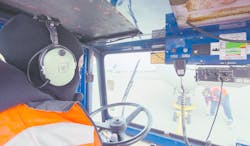Reliable communication on the ramp is a safety imperative, not a convenience. Wireless, noise-cancelling headsets allow ramp crews to maintain clear, constant communication with each other and those in aircraft while minimizing the noise of the ramp itself.
Wired headsets have been the norm on the ramp for decades, but in 2011, David Clark Company introduced their line of wireless headsets after decades of experience with in developing wired communications for a number of industries. For ground support, however, the going began slowly.
“Manufacturers have been trying to introduce wireless intercom headset systems to the ground support market for the better part of two decades,” Bob Daigle, product manager at David Clark Company, says. “And these earlier attempts have had little if any success in regards to reliability.”
You’ve Really Made the Grade
Early adoption bit back hard in the ground support industry. Early attempts at wireless headsets had poor reliability and, when they did work, didn’t have the ability to block environmental noise on the ramp. Eventually, ramp operations managers resorted back to wired communications.
David Clark had to cash in some reputation credibility to get system trials and, in a positive for the entire industry, the response was positive. In fact, across the industry, the move to wireless communication technology is improving and becoming standard operating procedure.
Today, David Clark’s 9900 headset series uses Digital Enhanced Cordless Telecommunications (DECT) radio technology to provide communication for up to four users per gateway and a 300 foot range.
DECT, as opposed to more popular commercial wireless technologies like Bluetooth, has a much stronger range and is preferable for networks with multiple users – not just one-to-one communication. In addition, DECT has been designed to work with a number of international telecommunications formats including ISDN, GSM and PSTN.
Outside of the radio technology, today’s wireless headsets include noise-cancelling features for both speaker, through noise-cancelling microphones and microphone guards, and listener, through well-insulated ear covers and in-ear noise cancellation via a microphone in the earpiece the picks up ambient noise and cancels it out to the listener with a soundwave of its own. It’s an obvious necessity, but a necessity nonetheless, that any headset on the ramp ensure clear communication for ground crews in an environment as loud and volatile as the ramp.
“We also offer various other headset communication options, such Bluetooth headsets for smartphone communications and a wide selection of options for mobile and portable radio interface,” Daigle says of David Clarks own offerings. “We innovated noise-attenuating headset communication back in the late 60’s/early 70’s, and have always had a strong focus on our headsets’ performance in high-noise environments.”
What’s a headset with sub-par ear protection? Nothing. Without insulation from the surrounding noise and, the added benefit of protection from the cold in the winter, the best microphone won’t help.
“It starts with effective hearing protection, as this not only affects the ability to hear what is being said through the headset without employing excessive earphone volume,” Daigle says. “But, for applications where the headset is worn for long periods, effective hearing protection reduces the level of noise fatigue, keeping the user more alert on the job.”
Daigle says headsets need the most effective noise-cancelling microphones, specifically tuned to human speech, to cancel background noise, including wind, so that critical information doesn’t need to be relayed twice. Daigle also says that David Clark Company’s dedication to product development is what has allowed them to push the boundaries on headset tech.
“We’ve also recently engineered several new lines of microphones that improve even further on these noise-cancelling properties, and have integrated these on all wireless headsets and will soon be offering these on all ground support headsets across the board,” Daigle says.
Sitting in a Tin Can
For tug drivers, the clarity and speed of communication is essential for safe, reliable handling and pushback.
“For example, take a tug operator working with a pair of wing-walkers at a gate for push-back,” Daigle says. “The way our wireless system works, all ground crew have hands free voice communication at normal speech volume, and the crew lead talks to the pilot when pressing a push-to-talk switch through a gateway plugged into the aircraft.”
Suddenly, with everyone on the same communications systems, the tug driver has three lookouts from three different perspectives – off of whom are communicating verbally, without the need for hand signals.
“So, if either of the wing-walkers sees an obstacle in danger of making contact with the aircraft during a push, they simply speak up as they see it,” Daigle says. “This way, the tug operator can avoid the hazard without having to see it themselves. This saves the crew and others from potential harm, while saving the airline money in terms of avoiding costly aircraft damage.”
Just as important as being heard, according to Daigle, is that his headsets are reliable at normal speech levels. Speech is undeniably faster than using hand signals, but when ramp crews need to shout, they might as well not even try speaking. What will they do the next day? Voices give out. Scheduling tests with any number of manufacturers will help find the best fit for your crew on your ramp.
Commencing Countdown, Engines On
The ultimate goal of ground support is obviously getting aircraft in the air as quickly and safely as possible. That goal is second only to the safety and wellbeing of the ground support team and passengers on the ramp. Not only does headset tech improve communication on the ramp, it improves ramp efficiency, safety and turnaround time at the gate and, as a result, saves airlines and airports hundreds of thousands of dollars in lost time and damages.
Open lines of communication, including allowing tug operators to verbally communicate with both pilots and wing watchers as opposed to relying on hand signals, contributes to improved on-time performance, avoidance of delays and cancellations based on damaging incidents and can even improve efficiency for aircraft maintenance and deicing.
PQ
“Manufacturers have been trying to introduce wireless intercom headset systems to the ground support market for the better part of two decades,” Bob Daigle, product manager at David Clark Company, says. “And these earlier attempts have had little if any success in regards to reliability.”
DECT, as opposed to more popular commercial wireless technologies like Bluetooth, has a much stronger range and is preferable for networks with multiple users – not just one-to-one communication.
Just as important as being heard is that his headsets are reliable at normal speech levels. Speech is undeniably faster than using hand signals, but when ramp crews need to shout, they might as well not even try speaking.
Not only does headset tech improve communication on the ramp, it improves ramp efficiency, safety and turnaround time at the gate.

